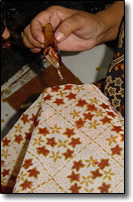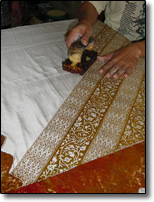Batik Making
Solo is a great place to shop for batik. We started at Danar Hadi. Behind the store, the museum, housed in a former palace, contains an outstanding collection of antique batik with excellent descriptions of the techniques and materials used at the time. After a guided tour of the museum, we visited the factory in the back where the high-end batik is still made. Sitting on the floor around small stoves, groups of women worked on the designs, dipping their styluses into the pots simmering on the stove, then drawing and covering patterns on the fabric with wax. Some of the more than 80 women were lying down or chatting with their colleagues. Our guide explained that these women, being artisans of traditions passed down from generation to generation, often from mother to daughter, were allowed to work at their own creative pace. Next door were the copy rooms, where the designs were drawn onto the fabric.
 |
 |
In the dyeing rooms, the fabric was put into the color baths to soak. In another room, men working on “cap” (stamped) batik, pressed repetitive patterns onto the cloth with hand presses dipped in hot wax. With a new understanding of the process, we searched for good deals in the smaller batik houses. After a little practice we could judge quality and see the difference between silkscreen, stamp and hand-drawn batik. When they discovered that we spoke Indonesian, some of the French gamelan students tagged along. At one store, a one of them wanted to buy fabric to make a pair of pants. We found a nearby tailor and helped her communicate what she wanted and bargain a price. Soon the others were asking to make clothes. The lucky tailor made some good business!
